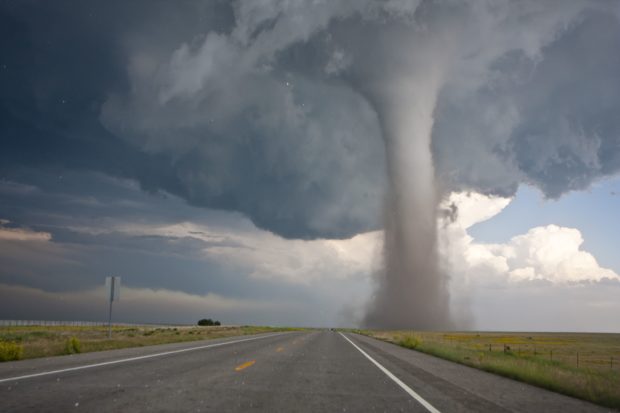Tornadoes, like all natural disasters, including floods, hurricanes, and earthquakes, can wreak havoc, cause disastrous damage to property, houses, infrastructure, and even cause deaths. Most of the damage is caused by airborne debris like trees that are uprooted and by roofs flying off homes and buildings.
Facts about Tornadoes
- Tornadoes are violent, short-lived, fast-rotating columns of air that occur on land and are known to be the most disastrous of all natural catastrophes.
- They are different than other natural disasters in that they are confined to a relatively small area of about only a few hundred meters wide.
- They are also known as Twisters
- Wind speed ranges from 110mph to 300mph and can hurl heavy objects.
- Most travel only a few miles before dissipating
- Between 1,000 and 1,200 tornadoes occur annually in the United States
- “Tornadoes can occur when a warm front meets a cold front, forming a thunderstorm, which can then spawn 1 or more “twisters.”
- Most tornadoes in the United States occur in Kansas, Florida, Texas, and Oklahoma
- The safest places to be during a tornado are storm cellars, underground storm shelters, or basements.
Insurance Coverage
Thinking you have insurance that covers natural disasters and finding out you don’t can be a costly mistake. Most basic home insurance policies do not cover natural disasters. Being underinsured can be as financially devastating as not being insured at all. Make sure you speak with your insurance provider to get a full understanding of what you are covered for and what you are not. If you live in a high-risk area for floods, earthquakes, hurricanes, or other natural disasters, make sure you purchase the additional coverage necessary to protect yourself financially.
Be Prepared Before the Storm
For starters, if you live in an area prone to tornadoes, you need to have a family tornado plan in place because being caught in the middle of a tornado can be terrifying. Since there is nothing you can do to prevent one, you should do everything you can to keep your loved ones safe. Practice tornado drills so that every family member knows exactly where to go. This should be a pre-determined area where you all meet in the event of a tornado. Some safety tips include:
- Stay away from windows
- If you have a below-ground basement, head to the basement
- If you find yourself outside, stay away from trees
- Pick a hallway in the center of a building if you are in a high-rise building
- Stay away from highway overpasses and bridges
- If you are in a mobile home, get out fast and find your way to a shelter or a permanent structure nearby.
- Protect yourself from flying debris by going into a closet, a small hallway, or even an interior bathroom. Putting on a football or bicycle helmet can add protection for your head.
- If you are in a car, leave it and try to get to a nearby ditch and do your best to protect your face and head.
Know the Signs
If your area is expecting a tornado, the national weather forecasting agencies or your local broadcasters will put out a tornado warning. However, it is entirely possible that you don’t hear the alert. In addition, weather forecasting is not exactly an exact science and some tornadoes do occur without any warning. There are a few signs that indicate an imminent tornado such as:
- Continuous and loud rumbling or roars that last more than a few seconds
- A massive rotating funnel-shaped cloud
- Persistent and strong rotation in the cloud base
- Large hail often in the absence of rain
- A strange calm after a thunderstorm
- Heavy rain or hail that is followed by an intense, fast wind shift or very still air
- A cloud of debris coming towards you or a dark, sometimes green sky
A tornado is extremely violent and dangerous and has the potential to destroy anything and everything in its path. Even if you do hear a warning, there is not much time between the alert and the event. The only things you can do are to be prepared with a plan, have packed emergency packs ready to grab, and know what signs you should be aware of that act as their own alert to an impending tornado.




